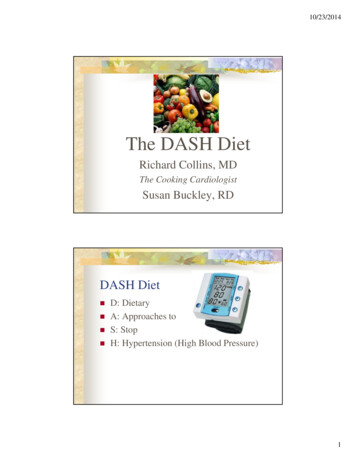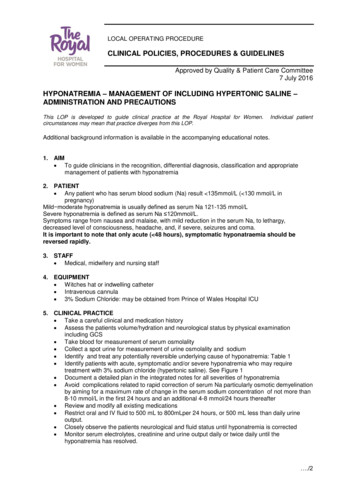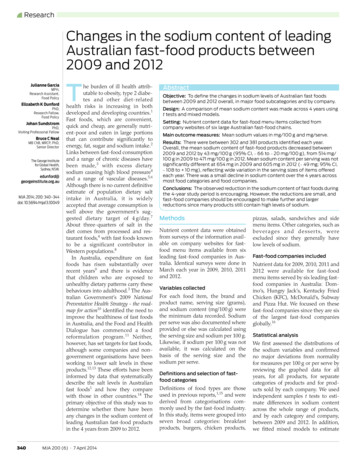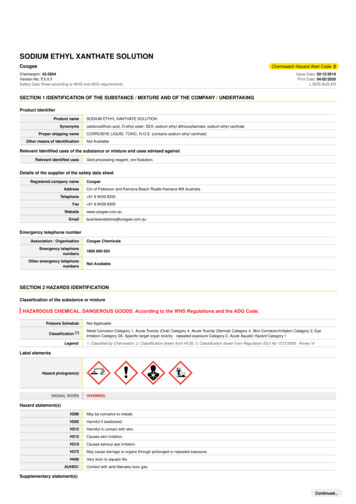
Transcription
SODIUM ETHYL XANTHATE SOLUTIONCoogeeChemwatch Hazard Alert Code: 2Chemwatch: 42-2604Version No: 7.1.1.1Safety Data Sheet according to WHS and ADG requirementsIssue Date: 02/12/2019Print Date: 04/02/2020L.GHS.AUS.ENSECTION 1 IDENTIFICATION OF THE SUBSTANCE / MIXTURE AND OF THE COMPANY / UNDERTAKINGProduct IdentifierProduct nameSynonymsProper shipping nameOther means of identificationSODIUM ETHYL XANTHATE SOLUTIONcarbonodithoic acid, O-ethyl ester; SEX; sodium ethyl dithiocarbamate; sodium ethyl xanthateCORROSIVE LIQUID, TOXIC, N.O.S. (contains sodium ethyl xanthate)Not AvailableRelevant identified uses of the substance or mixture and uses advised againstRelevant identified usesGold processing reagent, ore floatation.Details of the supplier of the safety data sheetRegistered company nameAddressCoogeeCnr of Patterson and Kwinana Beach Roads Kwinana WA AustraliaTelephone 61 8 9439 8200Fax 61 8 9439 @coogee.com.auEmergency telephone numberAssociation / OrganisationCoogee ChemicalsEmergency telephonenumbers1800 800 655Other emergency telephonenumbersNot AvailableSECTION 2 HAZARDS IDENTIFICATIONClassification of the substance or mixtureHAZARDOUS CHEMICAL. DANGEROUS GOODS. According to the WHS Regulations and the ADG Code.Poisons ScheduleClassification [1]Legend:Not ApplicableMetal Corrosion Category 1, Acute Toxicity (Oral) Category 4, Acute Toxicity (Dermal) Category 4, Skin Corrosion/Irritation Category 2, EyeIrritation Category 2A, Specific target organ toxicity - repeated exposure Category 2, Acute Aquatic Hazard Category 11. Classified by Chemwatch; 2. Classification drawn from HCIS; 3. Classification drawn from Regulation (EU) No 1272/2008 - Annex VILabel elementsHazard pictogram(s)SIGNAL WORDWARNINGHazard statement(s)H290May be corrosive to metals.H302Harmful if swallowed.H312Harmful in contact with skin.H315Causes skin irritation.H319Causes serious eye irritation.H373May cause damage to organs through prolonged or repeated exposure.H400Very toxic to aquatic life.AUH031Contact with acid liberates toxic gas.Supplementary statement(s)Continued.
Chemwatch: 42-2604Version No: 7.1.1.1Page 2 of 10Issue Date: 02/12/2019SODIUM ETHYL XANTHATE SOLUTIONPrint Date: 04/02/2020Not ApplicablePrecautionary statement(s) PreventionP260Do not breathe mist/vapours/spray.P234Keep only in original container.Precautionary statement(s) ResponseP321Specific treatment (see advice on this label).P322Specific measures (see advice on this label).Precautionary statement(s) StorageNot ApplicablePrecautionary statement(s) DisposalP501Dispose of contents/container to authorised hazardous or special waste collection point in accordance with any local regulation.SECTION 3 COMPOSITION / INFORMATION ON INGREDIENTSSubstancesSee section below for composition of MixturesMixturesCAS No%[weight]Name140-90-940sodium ethyl xanthate7732-18-560water75-15-0NotSpeccarbon disulfideNot Available(evolved)SECTION 4 FIRST AID MEASURESDescription of first aid measuresEye ContactSkin ContactInhalationIf this product comes in contact with the eyes:Wash out immediately with fresh running water.Ensure complete irrigation of the eye by keeping eyelids apart and away from eye and moving the eyelids by occasionally lifting the upperand lower lids.Seek medical attention without delay; if pain persists or recurs seek medical attention.Removal of contact lenses after an eye injury should only be undertaken by skilled personnel.If skin contact occurs:Immediately remove all contaminated clothing, including footwear.Flush skin and hair with running water (and soap if available).Seek medical attention in event of irritation.For thermal burns:Decontaminate area around burn.Consider the use of cold packs and topical antibiotics.For first-degree burns (affecting top layer of skin)Hold burned skin under cool (not cold) running water or immerse in cool water until pain subsides.Use compresses if running water is not available.Cover with sterile non-adhesive bandage or clean cloth.Do NOT apply butter or ointments; this may cause infection.Give over-the counter pain relievers if pain increases or swelling, redness, fever occur.For second-degree burns (affecting top two layers of skin)Cool the burn by immerse in cold running water for 10-15 minutes.Use compresses if running water is not available.Do NOT apply ice as this may lower body temperature and cause further damage.Do NOT break blisters or apply butter or ointments; this may cause infection.Protect burn by cover loosely with sterile, nonstick bandage and secure in place with gauze or tape.To prevent shock: (unless the person has a head, neck, or leg injury, or it would cause discomfort):Lay the person flat.Elevate feet about 12 inches.Elevate burn area above heart level, if possible.Cover the person with coat or blanket.Seek medical assistance.For third-degree burnsSeek immediate medical or emergency assistance.In the mean time:Protect burn area cover loosely with sterile, nonstick bandage or, for large areas, a sheet or other material that will not leave lint in wound.Separate burned toes and fingers with dry, sterile dressings.Do not soak burn in water or apply ointments or butter; this may cause infection.To prevent shock see above.For an airway burn, do not place pillow under the person's head when the person is lying down. This can close the airway.Have a person with a facial burn sit up.Check pulse and breathing to monitor for shock until emergency help arrives.If fumes or combustion products are inhaled remove from contaminated area.Lay patient down. Keep warm and rested.Prostheses such as false teeth, which may block airway, should be removed, where possible, prior to initiating first aid procedures.Continued.
Chemwatch: 42-2604Version No: 7.1.1.1Page 3 of 10Issue Date: 02/12/2019SODIUM ETHYL XANTHATE SOLUTIONPrint Date: 04/02/2020Apply artificial respiration if not breathing, preferably with a demand valve resuscitator, bag-valve mask device, or pocket mask as trained.Perform CPR if necessary.Transport to hospital, or doctor.Inhalation of vapours or aerosols (mists, fumes) may cause lung oedema.Corrosive substances may cause lung damage (e.g. lung oedema, fluid in the lungs).As this reaction may be delayed up to 24 hours after exposure, affected individuals need complete rest (preferably in semi-recumbentposture) and must be kept under medical observation even if no symptoms are (yet) manifested.Before any such manifestation, the administration of a spray containing a dexamethasone derivative or beclomethasone derivative may beconsidered.This must definitely be left to a doctor or person authorised by him/her.(ICSC13719)IF SWALLOWED, REFER FOR MEDICAL ATTENTION, WHERE POSSIBLE, WITHOUT DELAY.For advice, contact a Poisons Information Centre or a doctor.Urgent hospital treatment is likely to be needed.In the mean time, qualified first-aid personnel should treat the patient following observation and employing supportive measures as indicatedby the patient's condition.If the services of a medical officer or medical doctor are readily available, the patient should be placed in his/her care and a copy of the SDSshould be provided. Further action will be the responsibility of the medical specialist.If medical attention is not available on the worksite or surroundings send the patient to a hospital together with a copy of the SDS.IngestionWhere medical attention is not immediately available or where the patient is more than 15 minutes from a hospital or unless instructedotherwise:INDUCE vomiting with fingers down the back of the throat, ONLY IF CONSCIOUS. Lean patient forward or place on left side (head-downposition, if possible) to maintain open airway and prevent aspiration.NOTE: Wear a protective glove when inducing vomiting by mechanical means.Indication of any immediate medical attention and special treatment neededCarbon disulfide intoxication results in severe debilitating CNS symptoms (irritability, mania, hallucinations, tremors, memory loss).Chronic industrial exposures may cause neuropsychiatric changes, peripheral neuropathies and accelerated atherogenic changes.Peak blood concentrations appear 2 hours after inhalation. Plasma elimination half-life is about 1 hour. Metabolic products seen in urine include thiourea, 2-mercapto2-thiazolin-5-one and 2-thiothiazolidine-4-carboxylic acid (TTCA). The iodine-azide test identifies these.Initial management of severe inhalation poisoning requires careful attention to airway, breathing and circulation. Treatment involves symptomatic care.BIOLOGICAL EXPOSURE INDEX - BEIThese represent the determinants observed in specimens collected from a healthy worker exposed at the Exposure Standard (ES or TLV):DeterminantIndexSampling TimeComments2-Thiothiazolidine-4-carboxylic acid (TTCA) in urine5mg/gm creatinineEnd of shiftfor ----------------------BASIC --------------------Establish a patent airway with suction where necessary.Watch for signs of respiratory insufficiency and assist ventilation as necessary.Administer oxygen by non-rebreather mask at 10 to 15 l/min.Monitor and treat, where necessary, for pulmonary oedema .Monitor and treat, where necessary, for shock.Anticipate seizures.Where eyes have been exposed, flush immediately with water and continue to irrigate with normal saline during transport to hospital.DO NOT use emetics. Where ingestion is suspected rinse mouth and give up to 200 ml water (5 ml/kg recommended) for dilution where patient is able to swallow, has a stronggag reflex and does not drool.Skin burns should be covered with dry, sterile bandages, following decontamination.DO NOT attempt neutralisation as exothermic reaction may -----------------ADVANCED --------------------Consider orotracheal or nasotracheal intubation for airway control in unconscious patient or where respiratory arrest has occurred.Positive-pressure ventilation using a bag-valve mask might be of use.Monitor and treat, where necessary, for arrhythmias.Start an IV D5W TKO. If signs of hypovolaemia are present use lactated Ringers solution. Fluid overload might create complications.Drug therapy should be considered for pulmonary oedema.Hypotension with signs of hypovolaemia requires the cautious administration of fluids. Fluid overload might create complications.Treat seizures with diazepam.Proparacaine hydrochloride should be used to assist eye ----------------------EMERGENCY ---------------------Laboratory analysis of complete blood count, serum electrolytes, BUN, creatinine, glucose, urinalysis, baseline for serum aminotransferases (ALT and AST), calcium, phosphorusand magnesium, may assist in establishing a treatment regime.Positive end-expiratory pressure (PEEP)-assisted ventilation may be required for acute parenchymal injury or adult respiratory distress syndrome.Consider endoscopy to evaluate oral injury.Consult a toxicologist as necessary.BRONSTEIN, A.C. and CURRANCE, P.L. EMERGENCY CARE FOR HAZARDOUS MATERIALS EXPOSURE: 2nd Ed. 1994SECTION 5 FIREFIGHTING MEASURESExtinguishing mediaThe product contains a substantial proportion of water, therefore there are no restrictions on the type of extinguishing media which may be used. Choice of extinguishing media shouldtake into account surrounding areas.Special hazards arising from the substrate or mixtureFire IncompatibilityNone known.Continued.
Chemwatch: 42-2604Version No: 7.1.1.1Page 4 of 10Issue Date: 02/12/2019SODIUM ETHYL XANTHATE SOLUTIONPrint Date: 04/02/2020Advice for firefightersAlert Fire Brigade and tell them location and nature of hazard.Wear full body protective clothing with breathing apparatus.Fire FightingThe material is not readily combustible under normal conditions.However, it will break down under fire conditions and the organic component may burn.Fire/Explosion HazardHAZCHEMDecomposes on heating and produces toxic fumes of:carbon dioxide (CO2)sulfur oxides (SOx)other pyrolysis products typical of burning organic material.May emit corrosive fumes.2XSECTION 6 ACCIDENTAL RELEASE MEASURESPersonal precautions, protective equipment and emergency proceduresSee section 8Environmental precautionsSee section 12Methods and material for containment and cleaning upMinor SpillsDrains for storage or use areas should have retention basins for pH adjustments and dilution of spills before discharge or disposal ofmaterial.Check regularly for spills and leaks.Clean up all spills immediately.Avoid breathing vapours and contact with skin and eyes.Major SpillsClear area of personnel and move upwind.Alert Fire Brigade and tell them location and nature of hazard.Personal Protective Equipment advice is contained in Section 8 of the SDS.SECTION 7 HANDLING AND STORAGEPrecautions for safe handlingDO NOT allow clothing wet with material to stay in contact with skinAvoid all personal contact, including inhalation.Wear protective clothing when risk of exposure occurs.Safe handlingStore in original containers.Keep containers securely sealed.Other informationConditions for safe storage, including any incompatibilitiesSuitable containerLined metal can, lined metal pail/ can.Plastic pail.For low viscosity materialsDrums and jerricans must be of the non-removable head type.Where a can is to be used as an inner package, the can must have a screwed enclosure.Contact with acids produces toxic fumesAvoid any contamination of this material as it is very reactive and any contamination is potentially hazardousAvoid reaction with oxidising agentsStorage incompatibilitySECTION 8 EXPOSURE CONTROLS / PERSONAL PROTECTIONControl parametersOCCUPATIONAL EXPOSURE LIMITS (OEL)INGREDIENT DATASourceIngredientMaterial nameTWASTELPeakNotesAustralia Exposure Standardscarbon disulfideCarbon disulphide10 ppm / 31 mg/m3Not AvailableNot AvailableNot AvailableEMERGENCY LIMITSIngredientMaterial nameTEEL-1TEEL-2TEEL-3carbon disulfideCarbon disulfideNot AvailableNot AvailableNot AvailableIngredientOriginal IDLHRevised IDLHsodium ethyl xanthateNot AvailableNot AvailablewaterNot AvailableNot Availablecarbon disulfide500 ppmNot AvailableOCCUPATIONAL EXPOSURE BANDINGIngredientOccupational Exposure Band RatingOccupational Exposure Band Limitsodium ethyl xanthateE 0.01 mg/m³Continued.
Chemwatch: 42-2604Version No: 7.1.1.1Page 5 of 10Issue Date: 02/12/2019SODIUM ETHYL XANTHATE SOLUTIONPrint Date: 04/02/2020Occupational exposure banding is a process of assigning chemicals into specific categories or bands based on a chemical's potency and theadverse health outcomes associated with exposure. The output of this process is an occupational exposure band (OEB), which corresponds to arange of exposure concentrations that are expected to protect worker health.Notes:MATERIAL DATANone assigned. Refer to individual constituents.Exposure controlsAppropriate engineeringcontrolsEngineering controls are used to remove a hazard or place a barrier between the worker and the hazard. Well-designed engineering controls canbe highly effective in protecting workers and will typically be independent of worker interactions to provide this high level of protection.Engineering controls which have been generally implemented at mining sites include:enclosure and automation of the transfer and mixing process;enclosure of the cabin of the fork-lift or crane used for drum tipping;extraction ventilation systems above the area where drum contents are discharged into the mixing tank;local exhaust ventilation system with a water scrubber system above the mixing tank to absorb dust and gases or exhaust vents to theatmosphere via a short stack;bunding the area around the mixing tank so as to contain 100% of the tank volume;remote controlled dosing pumps;good general ventilation of the plant; and storage of solid sodium ethyl xanthate in well ventilated areas.The engineering controls vary at the different mine sites and all the listed controls are not present at all the sites.Personal protectionEye and face protectionSkin protectionHands/feet protectionBody protectionOther protectionSafety glasses with side shields.Chemical goggles.See Hand protection belowWear chemical protective gloves, e.g. PVC.Wear safety footwear or safety gumboots, e.g. RubberNOTE:The material may produce skin sensitisation in predisposed individuals. Care must be taken, when removing gloves and other protectiveequipment, to avoid all possible skin contact.The selection of suitable gloves does not only depend on the material, but also on further marks of quality which vary from manufacturer tomanufacturer. Where the chemical is a preparation of several substances, the resistance of the glove material can not be calculated in advanceand has therefore to be checked prior to the application.See Other protection belowOveralls.PVC Apron.Respiratory protectionType A Filter of sufficient capacity. (AS/NZS 1716 & 1715, EN 143:2000 & 149:2001, ANSI Z88 or national equivalent)Cartridge respirators should never be used for emergency ingress or in areas of unknown vapour concentrations or oxygen content.The wearer must be warned to leave the contaminated area immediately on detecting any odours through the respirator. The odour may indicate that the mask is not functioningproperly, that the vapour concentration is too high, or that the mask is not properly fitted. Because of these limitations, only restricted use of cartridge respirators is consideredappropriate.Cartridge performance is affected by humidity. Cartridges should be changed after 2 hr of continuous use unless it is determined that the humidity is less than 75%, in which case,cartridges can be used for 4 hr. Used cartridges should be discarded daily, regardless of the length of time usedSECTION 9 PHYSICAL AND CHEMICAL PROPERTIESInformation on basic physical and chemical propertiesAppearancePhysical stateClear orange liquid with an unpleasant odour; mixes with water.LiquidRelative density (Water 1)1.2OdourNot AvailablePartition coefficient n-octanol/ waterOdour thresholdNot AvailableAuto-ignition temperature ( C)Not AvailablepH (as supplied)Not AvailableDecomposition temperatureNot AvailableMelting point / freezing point( C)Not AvailableViscosity (cSt)Not AvailableInitial boiling point and boilingrange ( C) 100Molecular weight (g/mol)Not AvailableNot ApplicableFlash point ( C)Not AvailableTasteNot AvailableEvaporation rateNot AvailableExplosive propertiesNot AvailableFlammabilityNot AvailableOxidising propertiesNot AvailableNot AvailableUpper Explosive Limit (%)60 (CS2)Surface Tension (dyn/cm ormN/m)Lower Explosive Limit (%)0.6 (CS2)Volatile Component (%vol)Not AvailableVapour pressure (kPa)Solubility in waterVapour density (Air 1)Not AvailableMiscibleNot AvailableGas groupNot AvailablepH as a solution (1%)Not AvailableVOC g/LNot AvailableContinued.
Chemwatch: 42-2604Version No: 7.1.1.1Page 6 of 10Issue Date: 02/12/2019SODIUM ETHYL XANTHATE SOLUTIONPrint Date: 04/02/2020SECTION 10 STABILITY AND REACTIVITYReactivitySee section 7Unstable in the presence of incompatible materials.Product is considered stable.Chemical stabilityPossibility of hazardousreactionsSee section 7Conditions to avoidSee section 7Incompatible materialsSee section 7Hazardous decompositionproductsSee section 5SECTION 11 TOXICOLOGICAL INFORMATIONInformation on toxicological effectsInhaledIngestionThe material is not thought to produce respiratory irritation (as classified by EC Directives using animal models). Nevertheless inhalation ofvapours, fumes or aerosols, especially for prolonged periods, may produce respiratory discomfort and occasionally, distress.Inhalation of vapours or aerosols (mists, fumes), generated by the material during the course of normal handling, may be damaging to the healthof the individual.Acute inhalation of carbon disulfide produces rapid onset of both local irritation and central nervous system symptoms ranging from pharyngitis,nausea, vomiting, dizziness, fatigue, headache, mood changes, lethargy and blurred vision, to agitation, uncontrollable anger, suicidaltendencies, delirium, hallucinations, convulsions, coma and death.Carbon disulfide inhalation can result in local irritation and pharyngitis and central nervous system effects.Accidental ingestion of the material may be harmful; animal experiments indicate that ingestion of less than 150 gram may be fatal or mayproduce serious damage to the health of the individual.Skin contact with the material may be harmful; systemic effects may result following absorption.Skin ContactEyeChronicEvidence exists, or practical experience predicts, that the material either produces inflammation of the skin in a substantial number of individualsfollowing direct contact, and/or produces significant inflammation when applied to the healthy intact skin of animals, for up to four hours, suchinflammation being present twenty-four hours or more after the end of the exposure period. Skin irritation may also be present after prolonged orrepeated exposure; this may result in a form of contact dermatitis (nonallergic).The material may accentuate any pre-existing dermatitis conditionOpen cuts, abraded or irritated skin should not be exposed to this materialEntry into the blood-stream through, for example, cuts, abrasions, puncture wounds or lesions, may produce systemic injury with harmful effects.Examine the skin prior to the use of the material and ensure that any external damage is suitably protected.Evidence exists, or practical experience predicts, that the material may cause eye irritation in a substantial number of individuals and/or mayproduce significant ocular lesions which are present twenty-four hours or more after instillation into the eye(s) of experimental animals.Repeated or prolonged eye contact may cause inflammation characterised by temporary redness (similar to windburn) of the conjunctiva(conjunctivitis); temporary impairment of vision and/or other transient eye damage/ulceration may occur.Harmful: danger of serious damage to health by prolonged exposure through inhalation.Serious damage (clear functional disturbance or morphological change which may have toxicological significance) is likely to be caused byrepeated or prolonged exposure. As a rule the material produces, or contains a substance which produces severe lesions.Limited evidence suggests that repeated or long-term occupational exposure may produce cumulative health effects involving organs orbiochemical systems.There exists limited evidence that shows that skin contact with the material is capable either of inducing a sensitisation reaction in a significantnumber of individuals, and/or of producing positive response in experimental animals.Long-term exposure to carbon disulfide (CS2) may cause serious damage to the central nervous system (degeneration of the peripheral nerves),vision problems, liver and kidney damage, anaemia, fatigue and debility. Other symptoms of chronic exposure include insomnia, nightmares,defective memory and impotency.Repeated or prolonged exposure to corrosives may result in the erosion of teeth, inflammatory and ulcerative changes in the mouth and necrosis(rarely) of the jaw. Bronchial irritation, with cough, and frequent attacks of bronchial pneumonia may ensue.Long term or repeated ingestion exposure of isopropanol may produce incoordination, lethargy and reduced weight gain.Repeated inhalation exposure to isopropanol may produce narcosis, incoordination and liver degeneration.SODIUM ETHYL XANTHATESOLUTIONsodium ethyl xanthateTOXICITYIRRITATIONNot AvailableNot AvailableTOXICITYIRRITATIONOral (rat) LD50: 500 mg/kg[2]Eye: adverse effect observed (irritating)[1]Skin: adverse effect observed (corrosive)[1]watercarbon disulfideTOXICITYIRRITATIONOral (rat) LD50: 90000 mg/kg[2]Not AvailableTOXICITYIRRITATIONInhalation (rat) LC50: 25 mg/l/4h[2]Not AvailableOral (rat) LD50: 1200 mg/kg[2]Legend:SODIUM ETHYL XANTHATE1. Value obtained from Europe ECHA Registered Substances - Acute toxicity 2.* Value obtained from manufacturer's SDS. Unless otherwisespecified data extracted from RTECS - Register of Toxic Effect of chemical SubstancesAsthma-like symptoms may continue for months or even years after exposure to the material ceases. This may be due to a non-allergenicContinued.
Chemwatch: 42-2604Version No: 7.1.1.1Page 7 of 10Issue Date: 02/12/2019SODIUM ETHYL XANTHATE SOLUTIONPrint Date: 04/02/2020condition known as reactive airways dysfunction syndrome (RADS) which can occur following exposure to high levels of highly irritatingcompound. * [CCINFO - CHEMINFO]WATERCARBON DISULFIDENo significant acute toxicological data identified in literature search.NOTE: Substance has been shown to be mutagenic in at least one assay, or belongs to a family of chemicals producing damage or change tocellular DNA.Exposure to the material for prolonged periods may cause physical defects in the developing embryo (teratogenesis).Fatty liver degeneration, paternal effects, effects on fertility, foetotoxicity, effects on newborn recorded.Acute ToxicityCarcinogenicitySkin Irritation/CorrosionReproductivitySerious Eye Damage/IrritationSTOT - Single ExposureRespiratory or SkinsensitisationSTOT - Repeated ExposureMutagenicityAspiration HazardLegend:– Data either not available or does not fill the criteria for classification– Data available to make classificationSECTION 12 ECOLOGICAL INFORMATIONToxicityENDPOINTSODIUM ETHYL XANTHATESOLUTIONsodium ethyl xanthatewatercarbon disulfideLegend:TEST DURATION (HR)SPECIESVALUESOURCENot AvailableNotAvailableNotAvailableNotAvailableNot AvailableENDPOINTTEST DURATION e or other aquatic Crustacea0.92mg/L2ENDPOINTTEST DURATION Algae or other aquatic plants8768.874mg/L3ENDPOINTTEST DURATION stacea2.1mg/L2EC5096Algae or other aquatic plants21mg/L2EC1024Algae or other aquatic plants 32mg/L4NOEC240Fish 0.778mg/L4Extracted from 1. IUCLID Toxicity Data 2. Europe ECHA Registered Substances - Ecotoxicological Information - Aquatic Toxicity 3. EPIWIN SuiteV3.12 (QSAR) - Aquatic Toxicity Data (Estimated) 4. US EPA, Ecotox database - Aquatic Toxicity Data 5. ECETOC Aquatic Hazard AssessmentData 6. NITE (Japan) - Bioconcentration Data 7. METI (Japan) - Bioconcentration Data 8. Vendor DataPrevent, by any means available, spillage from entering drains or water courses.DO NOT discharge into sewer or waterways.Persistence and degradabilityIngredientPersistence: Water/SoilPersistence: AirwaterLOWLOWcarbon disulfideHIGHHIGHBioaccumulative potentialIngredientBioaccumulationwaterLOW (LogKOW -1.38)carbon disulfideLOW (BCF 8)Mobility in soilIngredientMobilitywaterLOW (KOC 14.3)carbon disulfideHIGH (KOC 1)SECTION 13 DISPOSAL CONSIDERATIONSContinued.
Chemwatch: 42-2604Version No: 7.1.1.1Page 8 of 10Issue Date: 02/12/2019SODIUM ETHYL XANTHATE SOLUTIONPrint Date: 04/02/2020Waste treatment methodsRecycle wherever possible.Consult manufacturer for recycling options or consult local or regional waste management authority for disposal if no suitable treatment ordisposal facility can be identified.Product / Packaging disposalSECTION 14 TRANSPORT INFORMATIONLabels RequiredMarine PollutantHAZCHEM2XLand transport (ADG)UN numberUN proper shipping name2922CORROSIVE LIQUID, TOXIC, N.O.S. (contains sodium ethyl xanthate)Class8Subrisk6.1Transport hazard class(es)Packing groupEnvironmental hazardIIIEnvironmentally hazardousSpecial provisions223 274Limited quantity5LSpecial precautions for userAir transport (ICAO-IATA / DGR)UN numberUN proper shipping name2922Corrosive liquid, toxic, n.o.s. * (contains sodium ethyl xanthate)Transport hazard class(es)Packing groupEnvironmental hazardICAO/IATA Class8ICAO / IATA Subrisk6.1ERG Code8PIIIEnvironmentally hazardousSpecial precautions for userSpecial provisionsA3 A803Cargo Only Packing Instructions856Cargo Only Maximum Qty / Pack60 LPassenger and Cargo Packing Instructions852Passenger and Cargo Maximum Qty / Pack5LPassenger and Cargo Limited Quantity Packing InstructionsY841Passenger and Cargo Limited Maximum Qty / Pack1LSea transport (IMDG-Code / GGVSee)UN numberUN proper shipping name2922CORROSIVE LIQUID, TOXIC, N.O.S. (contains sodium ethyl xanthate)IMDG Class8IMDG Subrisk6.1Transport hazard class(es)Packing groupEnvironmental hazardSpecial precautions for userIIIMarine PollutantEMS NumberF-A , S-BSpecial provisions223 274Limited Quantities5LContinued.
Chemwatch: 42-2604Version No: 7.1.1.1Page 9 of 10Issue Date: 02/12/2019SODIUM ETHYL XANTHATE SOLUTIONPrint Date: 04/02/2020Transport in bulk according to Annex II of MARPOL and the IBC codeNot ApplicableSECTION 15 REGULATORY INFORMATIONSafety, health and environmental regulations / legislation specific for the substance or mixtureSODIUM ETHYL XANTHATE IS FOUND ON THE FOLLOWING REGULATORY LISTSAustralia Dangerous Goods Code (ADG Code) - Dangerous Goods ListAustralia Dangerous Goods Code (ADG Code) - List of Emergency Action CodesAustralia Hazardous Chemical Information System (HCIS) - Hazardous ChemicalsAustralia Inventory of Chemical Substances (AICS)International Air Transport Association (IATA) Dangerous Goods RegulationsInternational Maritime Dangerous Goods Requirements (IMDG Code)United Nations Recommendations on the Transport of Dangerous Goods ModelRegulationsWATER IS FOUND ON THE FOLLOWING REGULATORY LISTSAustralia Inventory of Chemical Substances (AICS)IMO IBC Code Chapter 18: List of products to which the Code does not applyCARBON DISULFIDE IS FOUND ON THE FOLLOWING REGULATORY LISTSAustralia Dangerous Goods Code (ADG Code) -
Drains for storage or use areas should have retention basins for pH adjustments and dilution of spills before discharge or disposal of material. Check regularly for spills and leaks. Clean up all spills immediately. Avoid breathing vapours and contact with skin and eyes. Major Spills Clear area of personnel and move upwind.

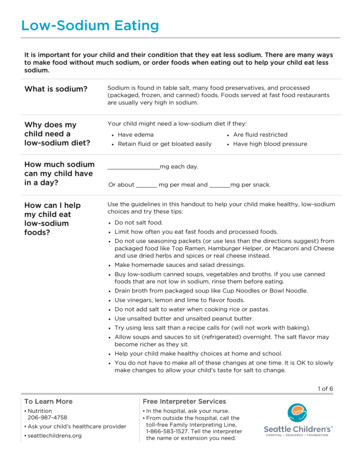
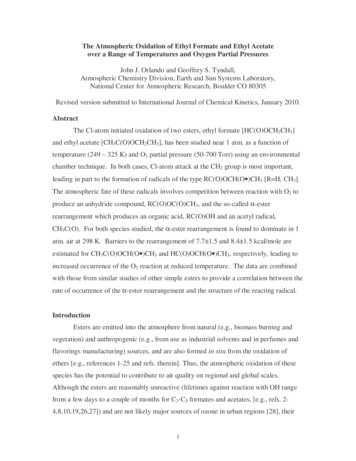
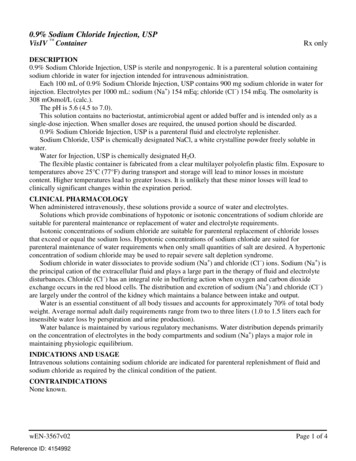

![Index [beckassets.blob.core.windows ]](/img/66/30639857-1119689333-14.jpg)


